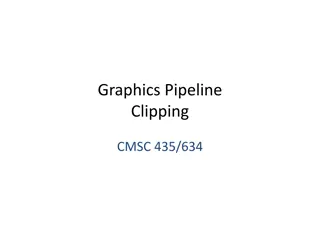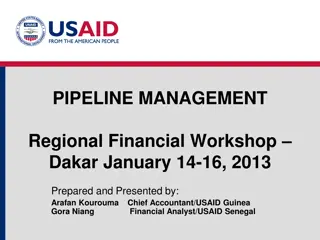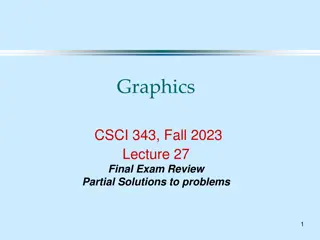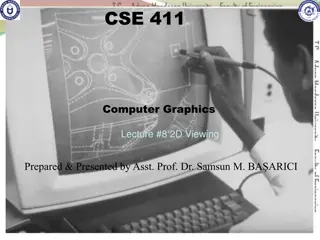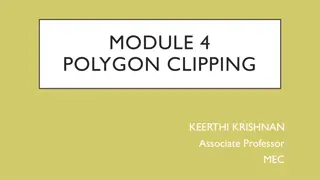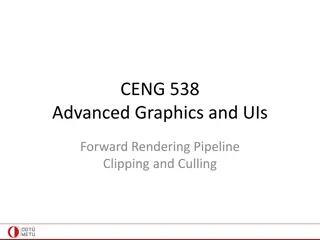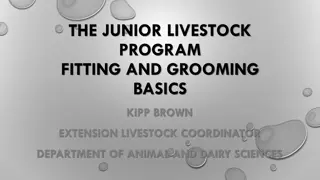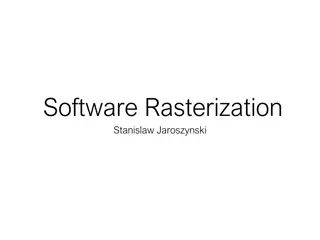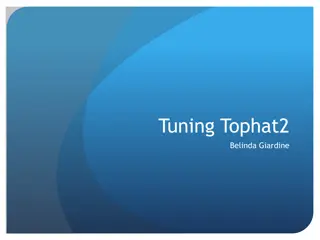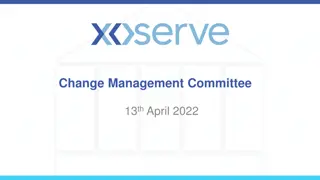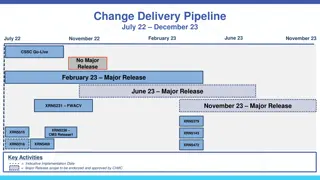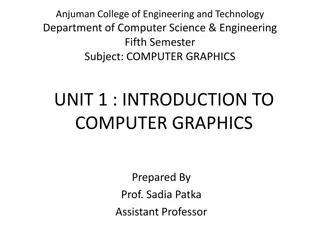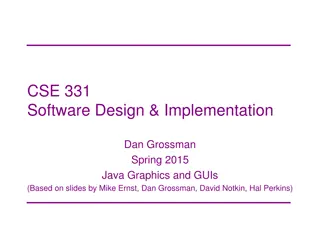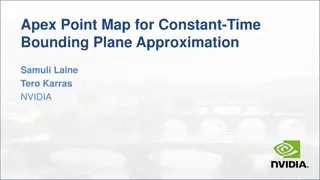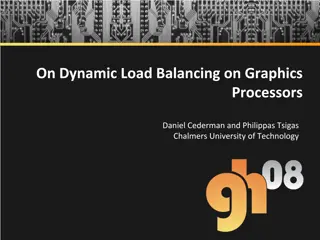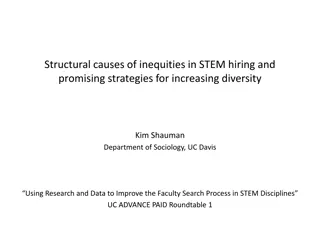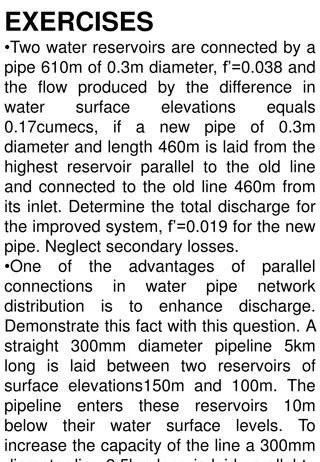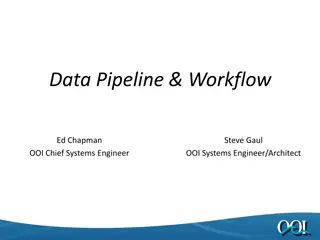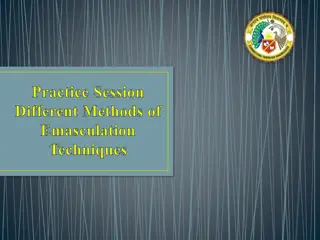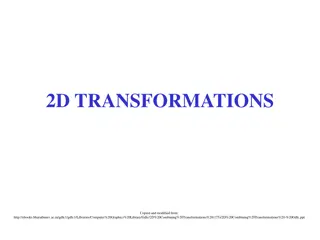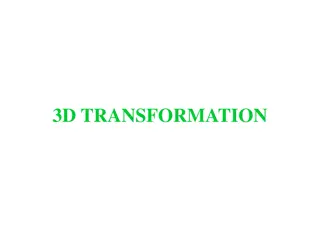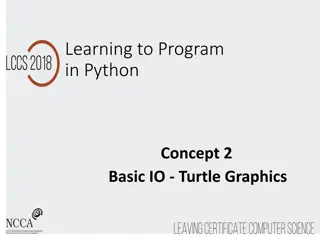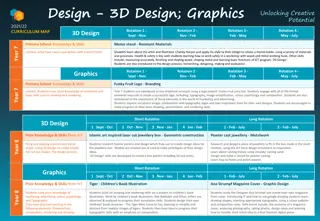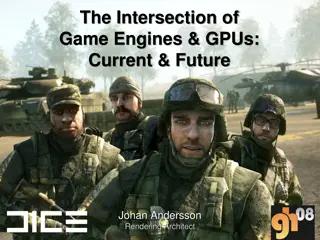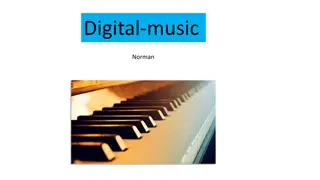Understanding Graphics Pipeline Clipping Techniques
Delve into the intricate process of graphics pipeline clipping in computer graphics, from breaking primitives into fragments to determining visible parts for rendering. Explore the necessity of clipping, culling, and endpoint conditions, as well as techniques like Cohen-Sutherland Line Clipping. Gain insights into why clipping is crucial for efficient rendering and how it enhances the overall graphics processing pipeline.
Download Presentation

Please find below an Image/Link to download the presentation.
The content on the website is provided AS IS for your information and personal use only. It may not be sold, licensed, or shared on other websites without obtaining consent from the author. Download presentation by click this link. If you encounter any issues during the download, it is possible that the publisher has removed the file from their server.
E N D
Presentation Transcript
Graphics Pipeline Clipping CMSC 435/634
Graphics Pipeline Object-order approach to rendering Transformations Vertex components of shading Vertex Processing Find the visible parts of primitives Clipping Break primitives into fragments/pixels Rasterization Fragment Processing Fragment components of shading Which do we see, how do they combine? Visibility & Blending
Why Clip? Window sides Draw less Some rasterization algorithms need everything on screen Near Draw less Don t divide by 0 Don t divide by negative z Far Draw less Constrain Z range (avoid overflow)
Clipping & Culling Cull: decide not to draw an object at all Clip: slice to keep just the visible parts Trivial Reject: Easy to decide entirely off screen Trivial Accept: Easy to decide entirely on screen 4
Clipping Lines Lines intersecting a rectangular clip region are always clipped into a single line segment Clip against one window edge at a time F D D D H B B C C H H J E A A G G J G I Clip Rectangle I 5
Clipping Endpoints For a point at (x,y) to be inside the clipping rectangle xmin x xmax, ymin y ymax 6
Clipping Conditions Both endpoints are inside (AB) One endpoint in, another end outside (CD) Both outside (EF, GH, IJ) May or may not be in, further calculations needed 7
Cohen-Sutherland Line Clipping First, endpoint pairs are checked for trivial acceptance If not, region checks are performed in order to trivially reject certain lines If both x s or both y s are < 1 or both are > 1, then it lies outside (EF) 8
Cohen-Sutherland Line Clipping Create bit code for each endopint Each region is assigned a 4-bit code (outcode) 1st bit above top edge y > ymax 2nd bit below bottom edge y < ymin 3rd bit right of right edge x > xmax 4th bit left of left edge x < xmin 9
Efficient Computation of Bit-Code Compute each bit First bit is the sign bit of ymax y Second bit is the sign bit of y ymin Third bit is the sign bit of xmax x Forth bit is the sign bit of x xmin 10
Bit-Code Trivial Rejects and Accepts If both bit codes are zero trivial accept If endpoints are both outside of same edge, they will share that bit This can easily be computed as a bitwise and (&) operation trivial reject if non-zero result If not, then need to split line at clip edge, discard portion outside, continue testing 11
Cohen-Sutherland Line Clipping Algorithm code1 = outcode from endpoint1 code2 = outcode from endpoint2 if (code1 | code2 == 0) then trivial_accept else if (code1 & code2 != 0) then trivial_reject else clip against left clip against right clip against bottom clip against top if (anything is left) then accept clipped segment 12
Homogeneous Clipping Works for 3D planes If point is inside clipping plane: Point on line: Intersection:
Polygon Clipping Many cases (new edges, discarded edges) Multiple polygons may result from a single (concave) polygon 14
Sutherland-Hodgman Polygon Clipping Divide and conquer Simpler problem is to clip polygon against a single infinite edge Sequence of 4 clips against clipping rectangle 15
Sutherland-Hodgman Polygon Clipping Algorithm moves around the polygon from vn to v1 and then on back to vn At each step Check (vi to vi+1) line against the clip edge Add zero, one, or two vertices to the output 16
Sutherland-Hodgman Polygon Clipping At each step, 1 of 4 possible cases arises 1) Edge is completely inside clip boundary, so add vertex p to the output 2) Intersection i is output as vertex because it intersects with boundary 3) Both vertices are outside boundary, so neither is output 4) Intersection i and vertex p both added to output list 17
Sutherland-Hodgman Algorithm Sutherland-Hodgman(array) vertex S = array[ length(array) - 1 ] for ( j = 0 ; j < length(array) ; j++ ) do vertex P = array[ j ] if ( P is inside clip plane ) then if ( S is inside clip plane ) then Output( P ) else Output( ComputeIntersection( S, P, clip plane ) ) Output( P ) elseif ( S is inside clip plane ) then Output( ComputeIntersection( P, S, clip plane ) ) else do nothing S = P /* case 1 */ /* case 4 */ /* case 2 */ /* case 3 */ 18


